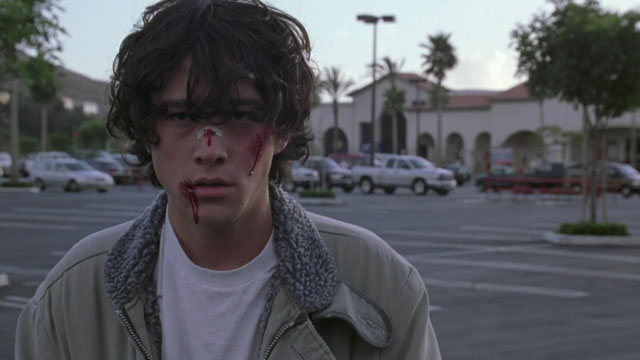It’s getting colder out there. It’s getting darker. In honor of “Noirvember,” Deadshirt’s decided to turn the spotlight on our favorite modern noir films of the last couple decades. Eyes forward, put the money in the bag and don’t get cute. This is Neo-Noirvember.
Part of what puts the “neo-” in “neo-noir” is the way modern filmmakers put an unusual spin on the classic film noir genre. Blade Runner is a noir set in the future; Memento is a noir run backwards. A cynical viewer could call these twists “gimmicks,” but however you might feel about them, they help filmmakers use the language of a favorite genre to tell a story that hasn’t been told before, and to stand out from the pack. As Dominic Griffin eloquently explained during our first Noirvember event last year, film noir is less a set of tropes or stock characters and more of a “powerful Instagram filter.” In his debut feature, Brick, writer-director Rian Johnson lays that noir filter over an unexpected setting: high school.
Brick is the story of Brenden Frye (Joseph Gordon-Levitt), a quiet, brilliant loner in a large California high school, who sets out to solve the murder of his beloved ex-girlfriend Emily (Emilie de Ravin). Brenden’s investigation bounces him between eccentric high school cliques and into the employ of The Pin (Lukas Haas), the top of the suburban drug trade. His quest is aided (or hindered?) by shady femme fatale Laura (Nora Zehetner) and deductive genius The Brain (Matt O’Leary). It’s a tale right out of a Dashiell Hammett novel (quite intentionally), projected onto a wall of adolescent angst and pretense.
In Brick, Brenden’s sprawling high school campus is practically a city in and of itself, with its own economy, its own rules, and its own slang. Within this microcosm of real life, the teenaged characters of the film seem to have complete autonomy—there are no scenes set in classrooms and no teachers wandering the halls. The only authority figure who appears in Brick is Assistant Vice Principal Gary Truman (Richard Roundtree), whose role is a single scene meant to mirror a rogue P.I.’s relationship with the police. Without the presence of adults in the story, the teenaged cast displays a weird balance of maturity and youthful foolishness, not unlike the troubled grown-ups who often populate conventional noir.
Film noir often dabbles in nihlism and hopelessness, of heroes who fight an uphill battle against a corrupt system and victims who authorities don’t even try to help. While Brick rarely calls attention to the age of the characters, the subtext of teenaged angst is all over the film. Brenden, like a lot of teenagers, feels alienated and misunderstood. He doesn’t trust the authorities to bring the people responsible for Emily’s murder to justice, and takes matters into his own hands out of cynicism and desperation. No one in Brick outright says “don’t trust anyone over thirty,” but the movie goes a step further and rarely even acknowledges anyone over thirty. In noir, God is dead; in Brick, it’s Mom and Dad. They’re not going to look out for you, they’re not going to believe you, you’ve got to solve your own problems. There’s the very essence of a P.I. story.
In the tradition of film noir, Brick is also a visually striking film, though not always in the way one might expect. While noir usually takes place in the dead of night with street lamps reflecting off of rainsoaked streets, Brick‘s high school setting means that much of Brenden’s investigation must take place during the day, under sunny California skies. There’s still the traditional play between light and shadow, but the color palette is distinctly different from other noirs. That the film is so visually interesting is all the more impressive considering its budget of only $475,000, which was applied frugally for some very clever practical effects.
Where Brick may lose people is in its heavily stylized dialogue, which some viewers may consider to be a little too cute. The script is peppered with slang terms and stilted ’40s-style phrases that the characters all instantly understand, but it can take new audiences a little time to catch up. This problem is compounded by the film’s poor sound mixing, a consequence of the low budget, no doubt. (Luckily, Rian Johnson published the shooting script online.) While the noir pastiche is heavy-handed to say the least, I’d argue that actually makes the film more believable. The world of Brick is not our own; the more the characters speak and behave like ordinary teenagers, the harder it is to prevent more, let’s say conventional logic from sneaking into the viewer’s mind. Complaining about the dialogue in Brick is like asking why Batman doesn’t just carry a gun—it’s missing the point entirely, and you’re better off just enjoying it for what it is.
But is it fair to use “gimmicky” to describe Brick and its ilk? For all the term’s negative connotations, it is essentially accurate. It’s an example of the elevator cliché, “The Big Sleep But With…” As with any high concept story, it’s not enough for the pitch to be interesting; the idea has to be executed with flair and originality. It’s not just the weird stylistic mashup that makes Brick worthy of praise; it’s writer-director Johnson’s crystal clear vision that elevates his debut film from film school pretense to true cult classic.
This has been Deadshirt’s Neo-Noirvember. We hope you’ll check out the rest of the installments in this month-long series.




